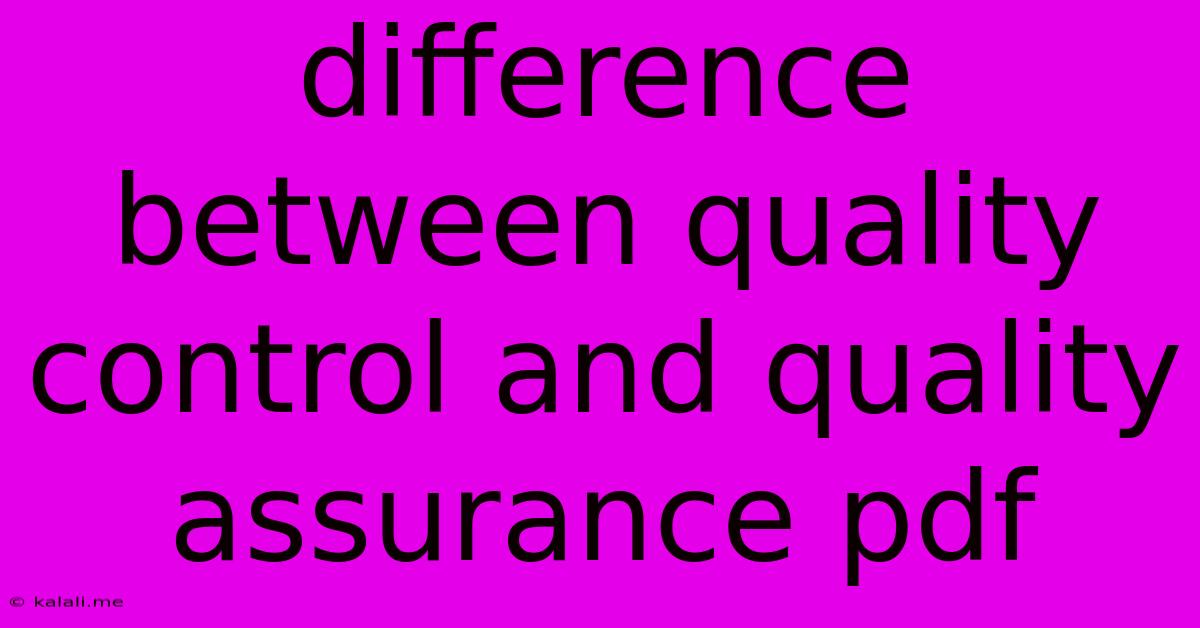Difference Between Quality Control And Quality Assurance Pdf
Kalali
Jun 14, 2025 · 3 min read

Table of Contents
Quality Control vs. Quality Assurance: A Comprehensive Guide
This article will delve into the key differences between quality control (QC) and quality assurance (QA), two crucial aspects of maintaining high product and service standards. While often used interchangeably, they represent distinct approaches with different goals and methodologies. Understanding these differences is essential for any organization aiming for operational excellence and customer satisfaction. We'll explore their definitions, processes, and the critical role they play in overall business success.
What is Quality Control (QC)?
Quality control is a reactive process focused on identifying defects after a product or service has been produced. It's a hands-on, inspection-based approach designed to ensure that individual outputs meet predetermined specifications. Think of QC as the final checkpoint before a product reaches the customer.
Key characteristics of QC:
- Reactive: Addresses problems after they occur.
- Product-focused: Concentrates on inspecting finished goods or services.
- Corrective: Aims to fix defects and prevent recurrence of the same issue in the same product/service.
- Inspection-oriented: Relies heavily on testing and inspection methods.
- Short-term focus: Primarily concerned with immediate product quality.
- Examples: Testing a batch of manufactured products for defects, inspecting a completed software build for bugs, reviewing a finished report for grammatical errors.
What is Quality Assurance (QA)?
Quality assurance, in contrast, is a proactive and preventative process. It focuses on establishing and maintaining a system that consistently delivers high-quality products or services. QA works to prevent defects from occurring in the first place by addressing the processes and procedures involved in production.
Key characteristics of QA:
- Proactive: Aims to prevent defects before they occur.
- Process-focused: Concentrates on improving the systems and processes that create products/services.
- Preventative: Implements measures to prevent defects from happening in the first place.
- System-oriented: Emphasizes continuous improvement and adherence to standards.
- Long-term focus: Aims for sustained high quality over time.
- Examples: Developing rigorous testing procedures, implementing a quality management system (like ISO 9001), conducting regular audits of production processes, providing training to employees on quality standards.
Key Differences Summarized:
| Feature | Quality Control (QC) | Quality Assurance (QA) |
|---|---|---|
| Focus | Product/Service | Process |
| Approach | Reactive, corrective | Proactive, preventative |
| Methodology | Inspection, testing | System improvement, process analysis, training |
| Goal | Identify and correct defects in finished outputs | Prevent defects from occurring in the first place |
| Timing | After production | Throughout the entire production process |
| Responsibility | Dedicated QC team or inspectors | Entire organization, including management |
The Synergistic Relationship Between QC and QA
While distinct, QC and QA are not mutually exclusive. They work best in conjunction, creating a robust quality management system. QA provides the framework and guidelines for preventing defects, while QC verifies the effectiveness of these measures and identifies any remaining issues. A strong QA system minimizes the workload on QC, leading to greater efficiency and cost savings.
Conclusion:
Understanding the differences between quality control and quality assurance is crucial for building a culture of quality within any organization. By effectively implementing both QC and QA strategies, businesses can significantly improve product and service quality, enhance customer satisfaction, and achieve a competitive advantage in the marketplace. Remember that a proactive, preventative approach (QA) coupled with robust verification (QC) is the key to consistent excellence.
Latest Posts
Latest Posts
-
For The Function F For Each Increase
Jun 14, 2025
-
Which Of The Following Species Has The Largest Radius
Jun 14, 2025
-
Chemicals That Resist Changes In Ph Are Called
Jun 14, 2025
-
What Is The Least Common Multiple Of 3 4 5
Jun 14, 2025
-
What Is Not A Primary Colour
Jun 14, 2025
Related Post
Thank you for visiting our website which covers about Difference Between Quality Control And Quality Assurance Pdf . We hope the information provided has been useful to you. Feel free to contact us if you have any questions or need further assistance. See you next time and don't miss to bookmark.